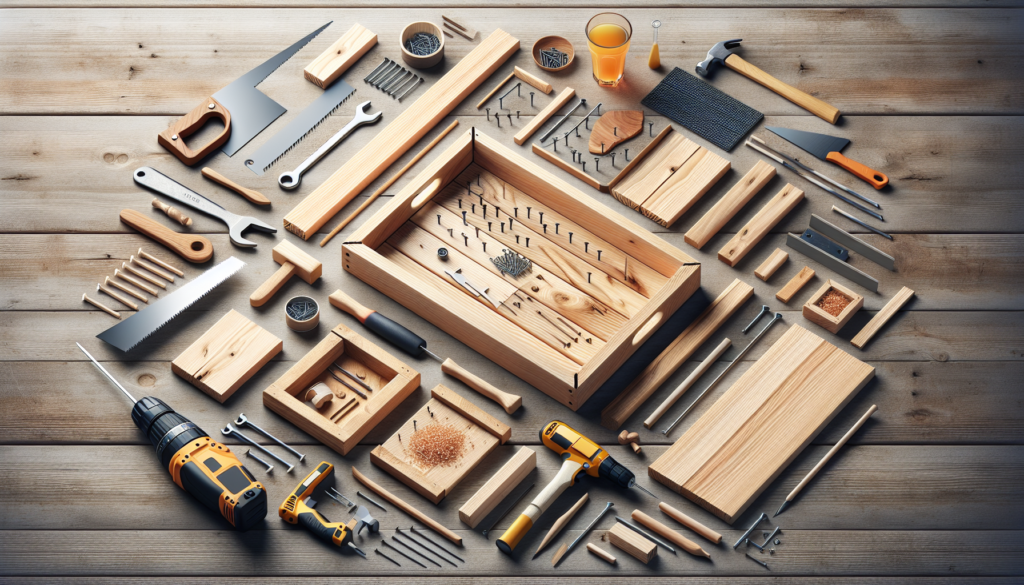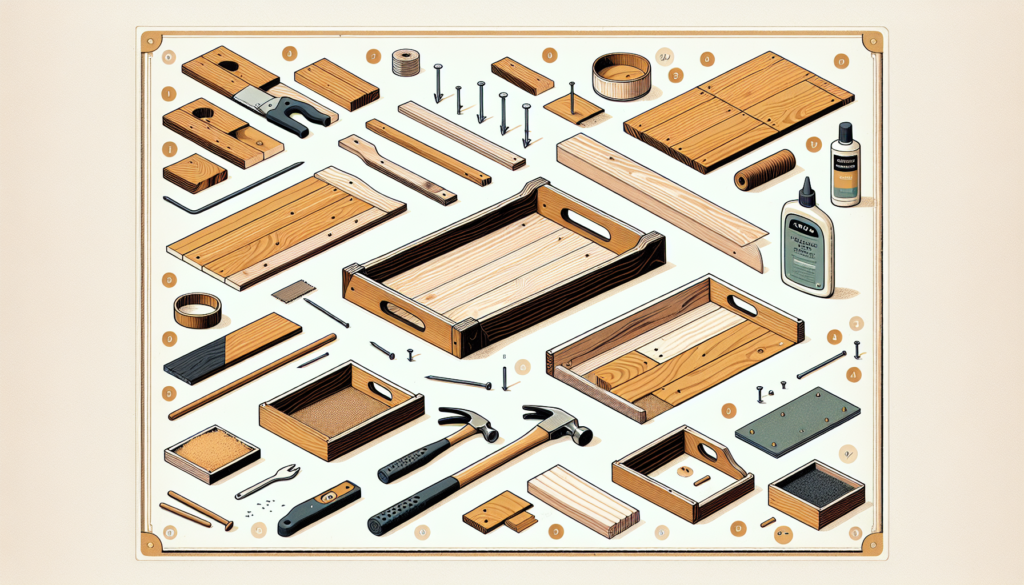How To Make A Wooden Serving Tray
So you’ve decided to try your hand at woodworking and want to start with a practical and aesthetically pleasing project – a wooden serving tray. Whether you’re looking to impress your guests or simply want to elevate your home entertaining, crafting a wooden serving tray can be a rewarding experience. In this article, we’ll guide you through the step-by-step process of how to make your own wooden serving tray, from selecting the right materials to adding those finishing touches that will make it truly unique. Get ready to roll up your sleeves and unleash your creativity as we embark on this exciting woodworking journey together.
How To Make A Wooden Serving Tray
Choosing the Right Wood
When it comes to making a wooden serving tray, choosing the right wood is essential. Consider the purpose of the tray first. Will it be used for serving food and drinks? Or will it be purely decorative? This will help determine the type of wood that would be most suitable.
Next, think about the desired size of the tray. Will it be used for serving a few small items, or do you need a larger tray to accommodate multiple dishes? This will help you determine the dimensions needed for the project.
Once you have a clear idea of the purpose and size, it’s time to choose the type of wood. Common options for serving trays include hardwoods like oak, maple, or walnut, as they are durable and visually appealing. Softwoods like pine or cedar can also be used, but they may require more care and maintenance.
Consider the wood grain pattern as well. Some people prefer a more rustic look with prominent grain patterns, while others may opt for a smoother and more uniform appearance. Think about what style you prefer and choose a wood that matches your vision.
Gathering the Necessary Tools
Before you start building your wooden serving tray, it’s important to gather all the necessary tools. Ensuring you have the right tools on hand will make the construction process much smoother.
First and foremost, don’t forget about safety equipment. Proper eye protection, gloves, and a dust mask are essential when working with wood. Your safety should always come first!
Measuring and marking tools are crucial for accuracy. A measuring tape, a combination square, and a pencil or marking knife will be your best friends during this project. These tools will allow you to measure and mark the wood precisely, ensuring that everything fits together perfectly.
Cutting tools are needed for shaping the wood. Depending on your preference and the complexity of the design, you may need a handsaw, a circular saw, or a jigsaw. Make sure to choose the appropriate tool for the job and keep safety in mind while cutting the wood.
Joinery tools will come into play when it’s time to join the wood pieces together. Depending on the joinery technique you choose, you may need tools such as a chisel, a mallet, or a router. Research the different joinery techniques and select the tools that align with your chosen method.
Sanding tools are necessary for creating smooth surfaces and removing any roughness. A sanding block or sandpaper in various grits will help you achieve the desired finish. Remember to sand in the direction of the wood grain for the best results.
Lastly, finishing tools are needed to apply a protective finish. Brushes, a foam applicator, or a spray gun may be used depending on the type of finish you choose. These tools will help ensure a professional-looking final result.

Preparing the Wood
Before you start building the tray, it’s important to prepare the wood properly. This will ensure that the finished product is sturdy, smooth, and able to withstand regular use.
First, acclimate the wood to the environment where it will be used. Wood expands and contracts with changes in humidity, so allowing it to adjust to the surrounding moisture level will prevent warping or cracking later on. This can be done by storing the wood in the intended space for a few days before starting the project.
Next, measure and mark the wood according to the desired dimensions for your tray. Use the gathered measuring and marking tools to ensure accuracy. Take your time with this step, as precise measurements are crucial for a professional-looking finished product.
Once the wood is marked, it’s time to cut it into the desired dimensions. Follow your markings carefully and use the appropriate cutting tools. Take your time and make smooth, controlled cuts to achieve clean edges.
After the rough cuts are made, it’s important to sand the surfaces to remove any roughness. Start with coarse-grit sandpaper to remove any imperfections and gradually move to finer grits for a smooth finish. Sand parallel to the wood grain to avoid creating visible scratches.
Consider adding handles or grips to your serving tray for added functionality and convenience. This can be done by cutting out specific shapes from the wood or attaching separate handles using screws or glue. Make sure they are securely attached and properly aligned for a comfortable and functional design.
Designing the Wooden Serving Tray
Designing the tray is an important step that allows you to customize the look and functionality of your serving tray.
Start by determining the shape of the tray. Will it be rectangular, square, round, or perhaps a unique shape? Consider both aesthetics and practicality when making this decision. Rectangular or square trays offer versatility, while round trays may provide a more visually appealing look.
Once you have decided on the shape, create a layout or blueprint of the tray. This can be a simple sketch on paper or a digital design using software. Include all the dimensions and features you want to incorporate, such as handles or decorative edges.
As you design, consider the functionality of the tray. Will it need to have raised edges to prevent spills? Should it have curved corners or straight lines? Tailor the design to meet your specific needs and preferences.

Cutting and Shaping the Wood
With the design planned and the wood prepared, it’s time to move on to cutting and shaping the wood pieces.
Start by marking the dimensions on the wood based on your design. Use your measuring and marking tools to ensure accuracy. Double-check your measurements before making any cuts to avoid any mistakes.
Next, use the appropriate cutting tools to cut the wood pieces according to your markings. Depending on the complexity of the design, this may involve straight cuts or more intricate shapes. Take your time and make precise cuts to achieve clean edges.
After the cuts are made, you may need to shape the edges of the wood to achieve the desired look. This can be done using sandpaper, a router, or other shaping tools. Carefully work on the edges to round them, create decorative profiles, or add any other desired details.
If your design includes joinery slots or holes for assembly, mark and make these cuts at this stage. Using the appropriate cutting tools, carefully create the necessary slots or holes to ensure a secure and sturdy final product.
Joining the Wood Pieces
Once the wood pieces are cut and shaped, it’s time to join them together to form the tray. Choosing the appropriate joinery technique is important for both structural integrity and aesthetic appeal.
Research different joinery techniques such as dovetail, mortise and tenon, or pocket screws. Consider the complexity of each technique and choose one that suits your skill level and desired outcome. Each joinery technique has its own advantages, so select the one that aligns with your needs and preferences.
Prepare the wood surfaces for joining by sanding them smooth and removing any dust or debris. This will ensure a strong bond when the glue is applied. Additionally, ensure that the wood pieces fit together properly by dry-fitting them before applying any glue or fasteners.
Once the wood pieces are prepared, apply a thin layer of glue to the mating surfaces and assemble the tray. Take care to line up the pieces accurately and use clamps to secure the assembly until the glue dries. Follow the manufacturer’s instructions for the type of glue you’re using to achieve the best results.
Using clamps will help ensure tight and even joints. Place the clamps strategically to distribute pressure evenly across the assembled piece. Remove any excess glue that squeezes out and wipe the joints clean for a neat finish.

Sanding and Smoothing
After the joinery is complete, it’s time to focus on sanding and smoothing the wood surfaces for a professional-looking finish.
Start with coarse-grit sandpaper and work your way up to finer grits. This process will help remove any visible glue marks, smooth out any imperfections, and create a consistent texture across the entire tray. Sand parallel to the wood grain, using light pressure, for the best results.
Pay close attention to the edges and corners, ensuring they are smooth and rounded. These areas are often the most visible and require extra care to achieve a polished appearance. Take your time and sand them carefully, checking your progress regularly.
Continue sanding until all surfaces, edges, and corners are smooth to the touch. Run your hand over the wood to feel for any roughness or inconsistencies. Sanding is a crucial step in achieving a professional and visually pleasing final product, so don’t rush through it.
Applying a Finish To The Wooden Serving Tray
Applying a finish to your wooden serving tray will not only enhance its natural beauty but also protect the wood from moisture and stains. Choosing the right finish for your specific use and aesthetic preference is important.
Consider the intended use of the tray when selecting a finish. If it will be used for serving food or drinks, a food-safe finish such as mineral oil or beeswax is recommended. For purely decorative trays, you can choose from a wider range of finishes such as polyurethane, lacquer, or shellac.
Read and follow the manufacturer’s instructions for applying the chosen finish. Apply the finish in a well-ventilated area, using a brush, foam applicator, or spray gun as recommended. Ensure even coverage and avoid drips or excess build-up.
Allow the finish to dry or cure according to the manufacturer’s instructions. This may take several hours or even days, depending on the type of finish. During this time, avoid touching or using the tray to prevent any smudges or damage to the finish.
Between coats, lightly sand the surface with fine-grit sandpaper to create a smoother finish. This will help remove any imperfections and promote adhesion between coats. Apply multiple coats if desired, following the same process of sanding between each coat.

Adding Decorative Touches To Your Wooden Serving Tray
To add a personal touch to your wooden serving tray, consider incorporating decorative elements.
One option is to add decorative inlays or carvings. This can be accomplished by cutting out specific shapes from contrasting wood or using a router to create intricate designs. Inlays or carvings can add visual interest and make your tray truly unique.
Wood stains or dyes can also be used to add color to the wood. Test the stain or dye on a scrap piece of wood to determine the desired shade and consistency before applying it to the tray. Follow the manufacturer’s instructions for best results.
If you have the skills and creativity, consider creating custom patterns or designs on the tray. This can be done using woodburning tools or by painting directly onto the wood. Ensure that any paints or materials used are compatible with the finish and won’t damage or change its appearance.
To preserve any decorative elements, apply a suitable protective coating over them. This will help prevent fading, chipping, or damage over time. Choose a finish that is compatible with the decorations and apply it carefully to ensure even coverage.
Final Touches and Quality Check
Before considering your wooden serving tray complete, take the time to perform a final quality check and make any necessary adjustments or refinements.
Inspect the tray for any excess glue that may have been missed during the clamping and cleaning process. Use a chisel or sandpaper to carefully remove any visible glue residue or rough spots.
Check that the tray is even and stable when placed on a flat surface. If necessary, make any adjustments to the joinery or sand the bottom surface of the tray to achieve stability.
Ensure that all the edges and corners of the tray are smooth and free from any splinters or sharp edges. Run your hand along each edge to feel for any roughness or inconsistencies.
Once you are satisfied with the final result, congratulate yourself on completing your wooden serving tray! It’s now ready to be used and enjoyed during special gatherings or for everyday use. Remember to take proper care of the tray to ensure its longevity and continued beauty.

For more decor projects check out our Wooden Bathroom Shelf

